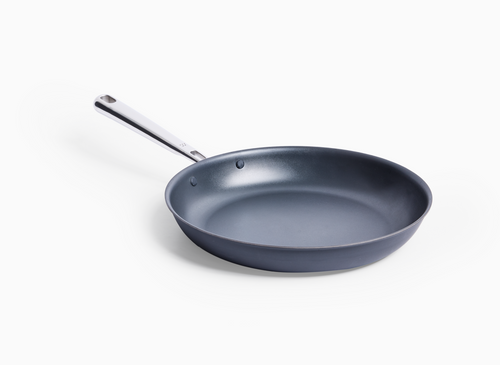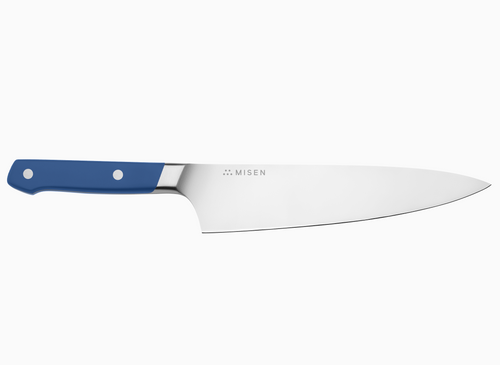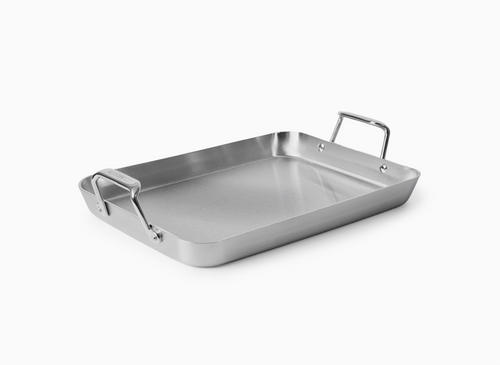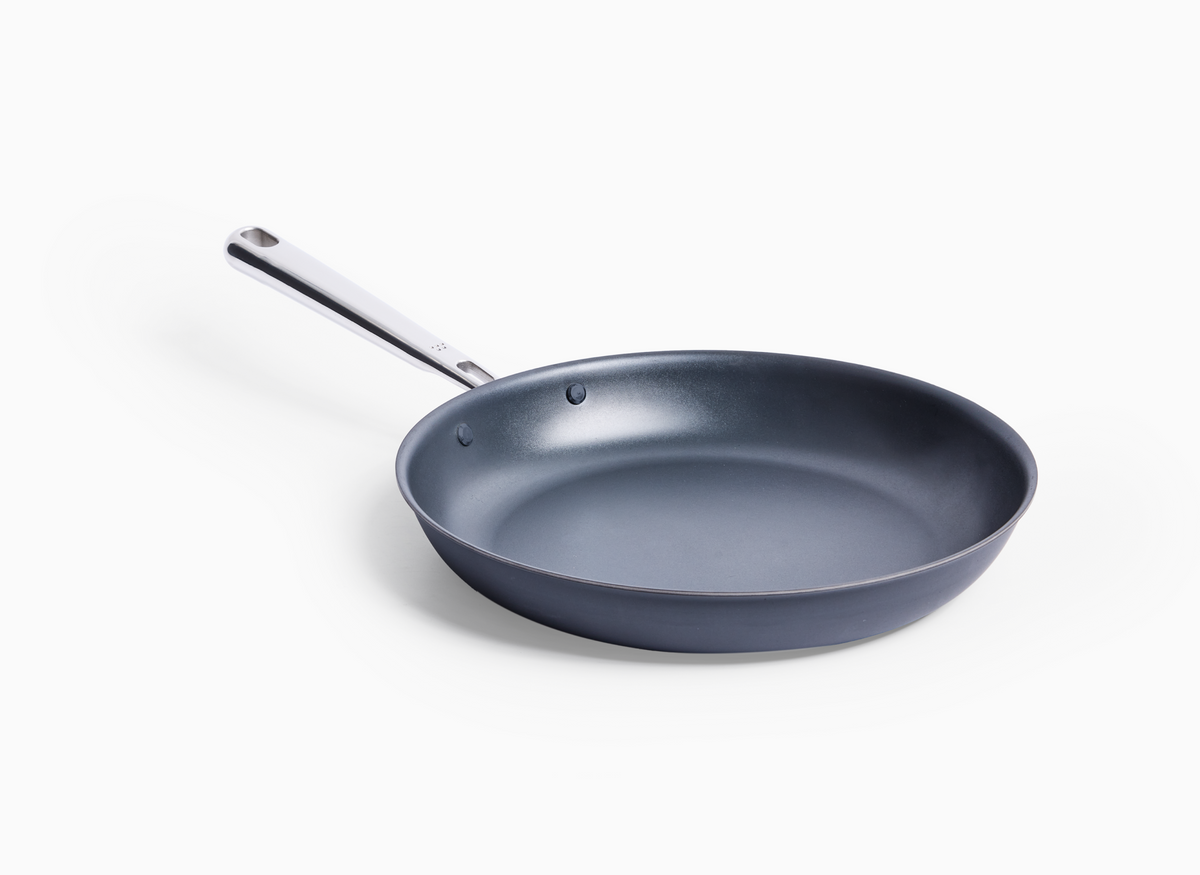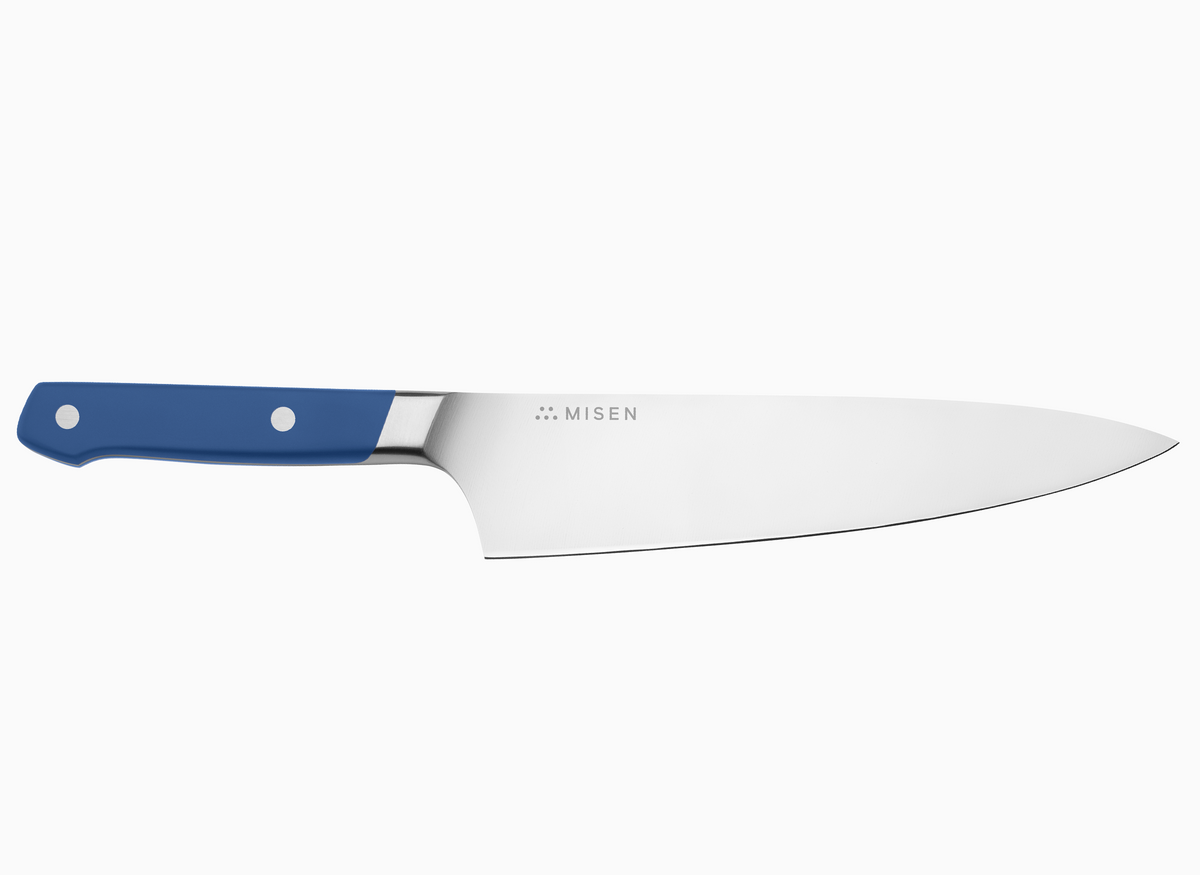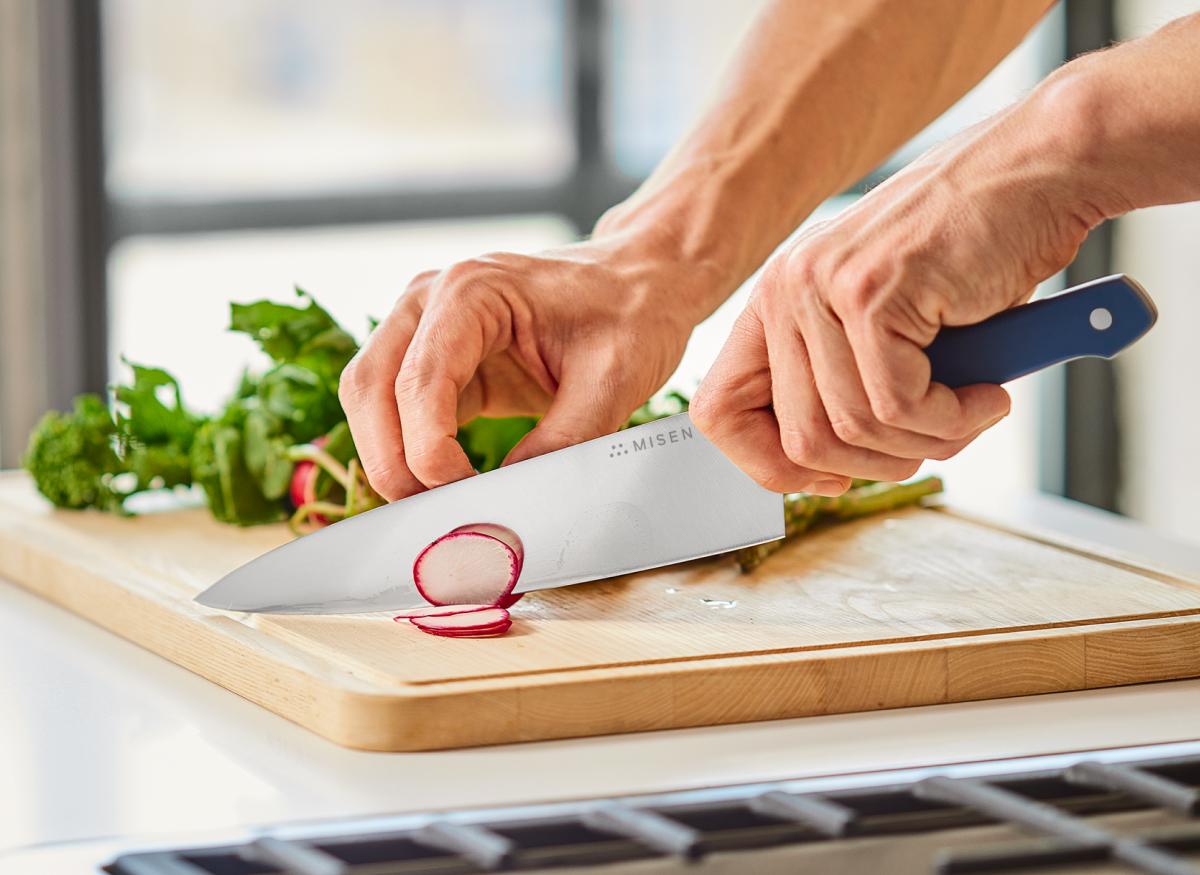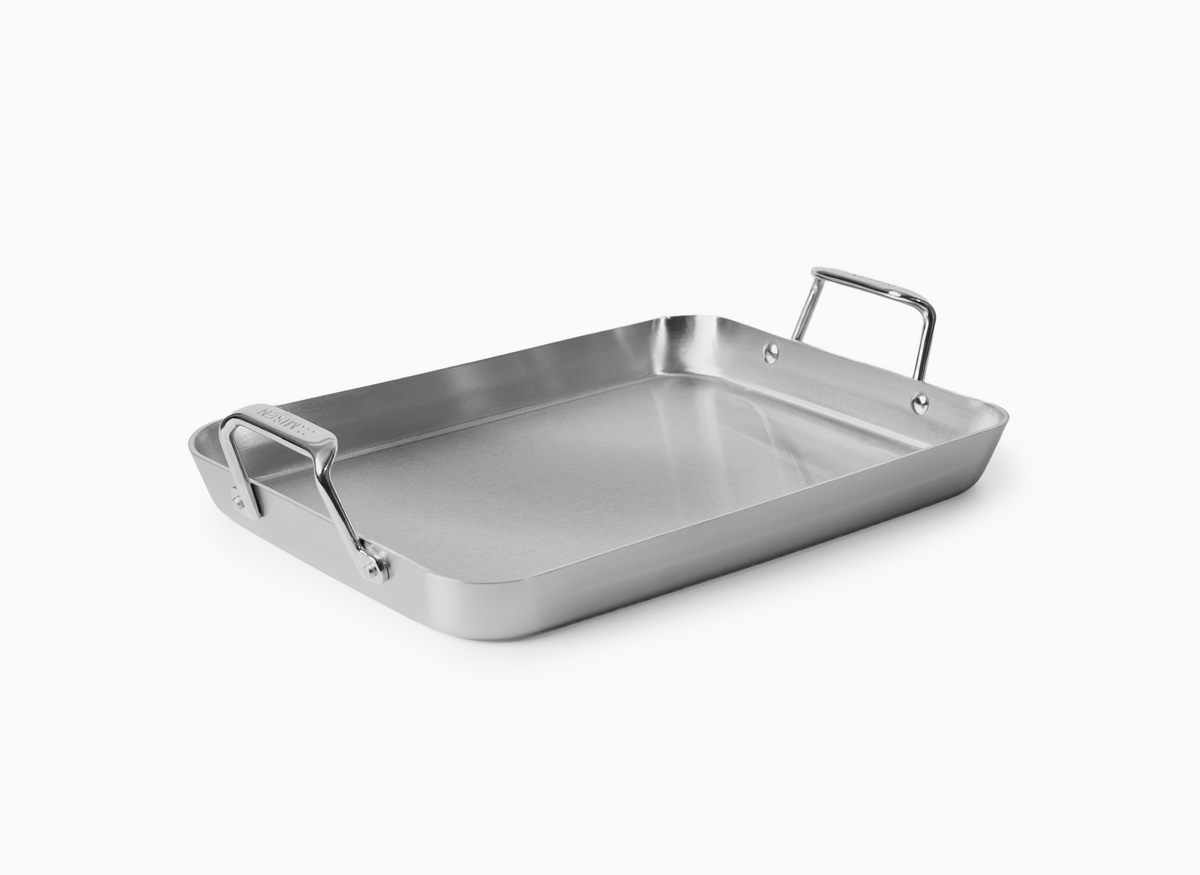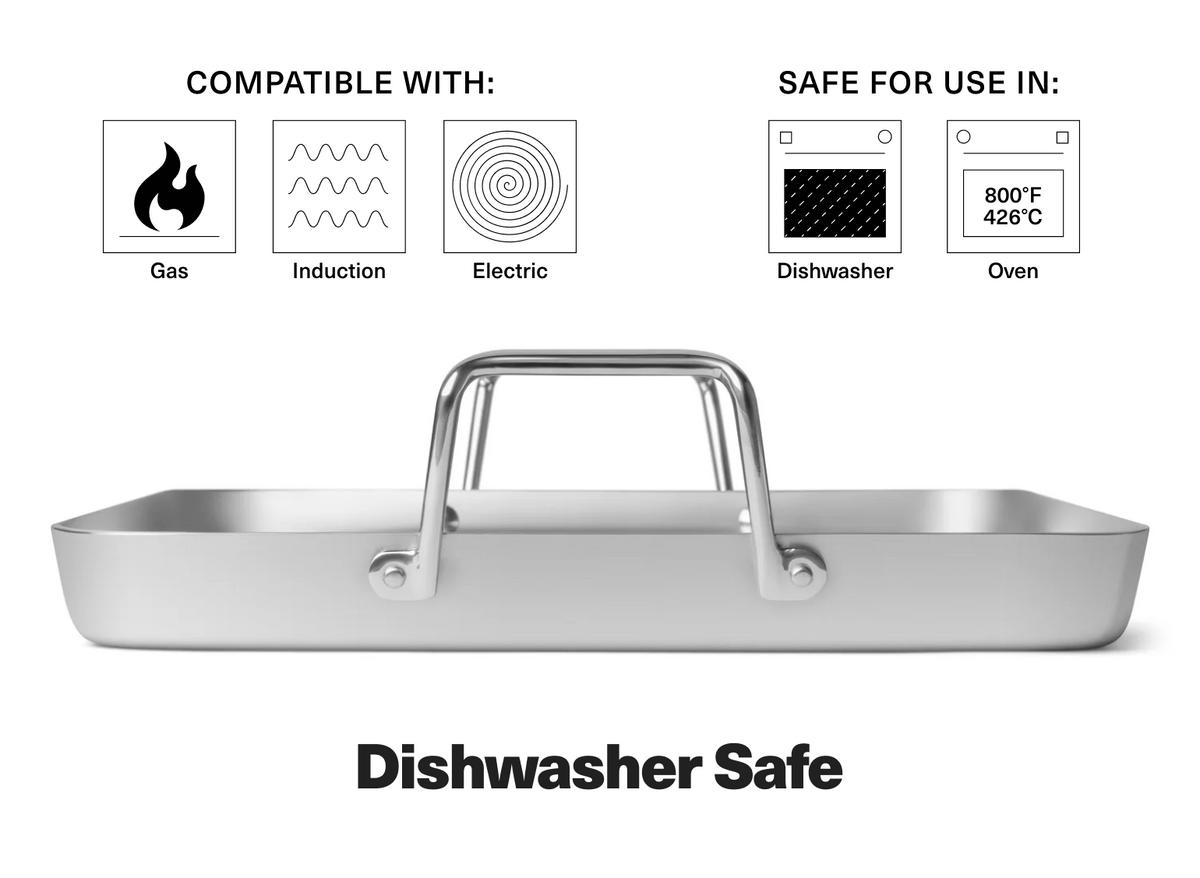Carbon Steel Skillet Essentials: How They Work and Why You Need One

- Summary
-
Selecting the Perfect Carbon Steel Skillet
- Essential Features to Look for When Purchasing Your First Skillet
- Size and Thickness Considerations for Different Cooking Needs
- Size and thickness considerations for different cooking needs
- Handle Design and Ergonomics: Finding Your Perfect Grip
- Top Brands Worth Investing In: Price Points and Quality Comparison
- Key Takeaways
- References
Carbon steel skillets deliver the responsive heat of aluminum and the heat retention of cast iron in a lighter, more agile pan that gets better with age, making them the ultimate kitchen workhorse for everything from searing steaks to frying eggs. This guide demystifies the science behind 99% iron/1% carbon construction, shows how rapid heating and even heat eliminate hot spots, and explains why a natural, ever-improving seasoning layer outperforms and outlasts synthetic nonstick coatings. Readers will learn to match pan weight, size, handle design, and pre-seasoning to their cooking style; master stovetop-to-oven techniques; and avoid acid or long, wet simmers that strip seasoning. With tips on temperature control, best-use foods, and selecting budget to artisan pans, the article equips home cooks to choose one versatile, heirloom-quality skillet that replaces multiple pans, saves money, and slashes environmental waste.
Understanding Carbon Steel: Composition and Properties
That mere 1% carbon—far less than cast iron’s 2–3%—lets manufacturers press carbon steel into thin, uniformly structured sheets that heat faster and more evenly while you cook.
What Exactly Is a Carbon Steel Skillet? Material Science Explained
Think of carbon steel as the perfect middle ground in cookware materials. These skillets contain about 99% iron and just 1% carbon—a simple recipe that creates something special [1]. That small amount of carbon (cast iron has 2-3%) makes all the difference in how your pan performs [1]. Here's what's happening at the molecular level: with less carbon, the metal forms a more uniform structure. The carbon doesn't clump up or create weak spots like it does in cast iron [1].
This uniformity gives manufacturers the ability to shape carbon steel by pressing and cutting it from sheets—similar to cutting cookies from dough [1]. The manufacturing process is fascinating. Makers roll the hot metal between heavy rollers, then rapidly cool it with water or oil. This "locks in" the ideal grain structure, creating cookware that heats quickly and evenly [1]. You get the responsiveness you need for precise cooking, with fewer hot spots than cast iron [2].
When browsing for pans, you'll see terms like "blue steel" and "black steel. " Don't let these confuse you—they simply describe different rust-prevention treatments that give the pans their distinctive colors [1]. Both types perform equally well in your kitchen [1].
Carbon Steel vs. Cast Iron: Cousins with Crucial Differences
Information about carbon steel versus cast iron comparisons is integrated throughout other sections of this guide where specific properties are discussed.
The Stainless Steel and Nonstick Alternatives: How Carbon Steel Compares
Let's compare carbon steel to its main kitchen competitors: stainless steel and nonstick cookware. Each has its place, but understanding the differences helps you choose the right tool for each cooking task. Stainless steel pans (typically 18/10 grade with 18% chromium and 10% nickel) excel at handling acidic foods. You can simmer tomato sauce or deglaze with wine without worry—something that would damage carbon steel's seasoning [5]. Plus, stainless steel needs no seasoning and usually survives the dishwasher just fine [5].
But here's the trade-off: stainless steel doesn't conduct heat as efficiently as carbon steel. Manufacturers often add aluminum or copper layers to compensate, creating heavier, more expensive pans that respond slowly to temperature changes [4]. When you need quick heat adjustments for stir-frying or want that perfect sear, carbon steel's responsiveness gives you better control [5]. Food release tells another story. Well-seasoned carbon steel develops a natural nonstick surface that actually improves over time—no synthetic coatings needed [5].
Stainless steel requires more fat and proper technique to prevent sticking [4]. Weight-wise, carbon steel splits the difference—lighter than cast iron for easier handling, but with more heft than stainless steel for better heat retention [4]. The bottom line? Choose stainless steel when you're cooking acidic foods or want low-maintenance cookware. Reach for carbon steel when you need responsive heat control, excellent searing, or prefer a naturally nonstick surface that gets better with age [5].
The Perfect Balance: Lightweight Design with Heavy-Duty Performance
Here's something many cooks discover: carbon steel offers the perfect weight balance for everyday cooking. A typical 12-inch carbon steel pan weighs about 5 pounds 10 ounces—roughly 1. 5 pounds lighter than cast iron [7]. That difference might not sound like much, but your wrist will thank you during longer cooking sessions. This moderate weight delivers real cooking benefits. You can actually flip and toss ingredients one-handed (try that with heavy cast iron!
) while still having enough heft for proper heat retention [7]. When you're searing steaks or stir-frying vegetables, that stability matters. Why does weight matter so much? Heavier pans resist warping and hold heat better—meaning your cooking temperature stays steady even when you add cold ingredients [6]. But lighter pans heat up faster and make active cooking techniques easier [6]. Carbon steel gives you both advantages: quick heating when you need it, plus enough thermal mass for consistent temperatures.
The sloped sides of most carbon steel pans work perfectly with their manageable weight. Those gentle curves create natural ramps for tossing food—something straight-sided cast iron can't match [7]. You get maximum cooking surface without unnecessary bulk. For home cooks, this weight balance means you can cook longer without fatigue. Even professional chefs, who sometimes develop repetitive strain from lifting heavy pans all day, appreciate carbon steel's more manageable heft [7]. It's substantial enough for serious cooking but light enough for everyday use—truly the best of both worlds.
The Unique Advantages of Cooking with Carbon Steel
Carbon steel gives you cast-iron heat retention with aluminum-level responsiveness, letting you sear steak, scramble eggs, bake chicken, or stir-fry anywhere—stovetop, oven, grill, campfire—in one do-it-all pan.
Superior Heat Conductivity: The Science Behind Even Cooking
Here's what makes carbon steel special: it heats up quickly like aluminum but holds heat like cast iron, giving you the best of both worlds [10]. As we discussed earlier, that simple 99% iron and 1% carbon composition creates a uniquely responsive cooking surface [9]. In your kitchen, this translates to real control.
Need to sear a steak then immediately lower the heat for a gentle finish? Carbon steel responds instantly to temperature changes, unlike cast iron that takes its time cooling down [9]. The even heat distribution means no more hot spots that burn your onions while leaving others raw [8].
This responsiveness is why professional chefs reach for carbon steel when precision matters – getting that perfect crust on proteins while keeping the inside exactly where you want it [9]. Whether you're searing at high heat or gently cooking eggs, you'll have the control you need [8].
Versatility Across Cooking Techniques and Heat Sources
Your carbon steel pan works everywhere – gas, electric, induction stovetops, ovens, grills, even over a campfire [11]. This go-anywhere versatility means one pan handles countless cooking tasks, from weeknight dinners to weekend camping trips. The real magic happens when you put that versatility to work. Want restaurant-quality seared steaks?
Carbon steel's quick heat response delivers that perfect crust [12]. Stir-frying? The sloped sides and responsive temperature control keep everything moving at just the right heat [12]. Even delicate foods like fish and eggs release beautifully once your pan develops its seasoning [12].
What makes carbon steel a kitchen workhorse is how seamlessly it transitions between techniques. Start your chicken on the stovetop for crispy skin, then slide the whole pan into the oven to finish cooking [12]. This flexibility is why both professional chefs and home cooks rely on these pans daily – they handle everything from morning scrambled eggs to evening stir-fries with equal ease [12]. Pre-seasoned carbon steel pans offer immediate versatility right out of the box.
Developing Natural Non-Stick Properties Through Use
The more you cook with carbon steel, the better it gets. Through a natural process called seasoning, oils from cooking polymerize and bond with the metal surface, creating layers of natural nonstick coating. Unlike synthetic nonstick pans that degrade over time, carbon steel's seasoning actually improves with use.
Each time you cook with fat or oil, you're building up this protective layer. Bacon, roasted vegetables, and seared meats all contribute to developing that glossy, dark patina that makes eggs slide around effortlessly. The best part?
If your seasoning gets damaged, you can simply re-season the pan and start fresh – something impossible with traditional nonstick cookware. To maintain and enhance these nonstick properties, cook with adequate fat, avoid harsh scrubbing, and give your pan a quick wipe of oil after cleaning. With regular use and basic care, your carbon steel will develop a seasoning that rivals any nonstick pan – naturally and without chemicals.
Longevity and Sustainability: Why Carbon Steel Skillets Last Generations
Here's a refreshing truth: your carbon steel pan could outlive you. While nonstick pans need replacing every three to five years, carbon steel cookware becomes a family heirloom with basic care [14]. This isn't just good for your wallet – it's great for the planet too. Think about it: most of a pan's environmental impact happens during manufacturing, from mining materials to shipping the finished product [14].
When you buy one carbon steel pan that lasts generations instead of replacing nonstick pans every few years, you're making a real difference [14]. Like cast iron, carbon steel actually gets better with age. That seasoning we talked about? It keeps improving year after year, decade after decade [14].
Yes, you'll need to dry it thoroughly and give it an occasional oil wipe to prevent rust, but that small effort rewards you with cookware that your grandchildren might fight over someday [14]. For cooks who care about sustainability without sacrificing performance, carbon steel delivers on both fronts – proving that the most eco-friendly choice is often the one that simply lasts [14].
Mastering Cooking Techniques with Carbon Steel
Master your carbon steel skillet by starting on medium heat, using the dancing-water test to nail the perfect temperature, then sear with confidence—its ultra-smooth surface holds heat so steadily that every steak lands a restaurant-grade crust.
Optimal Heat Management: Preheating and Temperature Control
Getting the most from your carbon steel skillet starts with understanding its unique heating behavior. Unlike thicker cookware, carbon steel heats up remarkably fast—often reaching cooking temperature in just 2-3 minutes [23]. This responsiveness means you'll need to adjust your cooking habits accordingly. Start with medium heat rather than high, as the pan's excellent conductivity can quickly lead to overheating [23].
To check if your pan's ready, try the water drop test: flick a few drops of water onto the surface. When they form perfect mercury-like beads that dance across the pan, you've hit the sweet spot for cooking [8]. For searing, wait until a drop of water evaporates on contact—that's when you know you've reached the high temperatures needed for perfect crusts. Temperature control becomes intuitive once you understand how carbon steel responds.
The material's quick heat adjustment means you can seamlessly transition between techniques—start with high heat for searing, then immediately reduce to medium-low for gentle cooking [8]. This responsiveness gives you the control professional chefs rely on, allowing precise adjustments that prevent burning while maximizing flavor development.
Searing Perfection: Why Carbon Steel Creates the Best Crust
Want restaurant-quality crusts at home? Carbon steel delivers like no other cookware can. The secret lies in how well these pans hold heat—when you place that cold steak on the surface, the temperature barely budges, ensuring you get that deep, even sear every time [7]. Here's what makes carbon steel unbeatable for searing: its ultra-smooth surface creates complete contact with your food.
Unlike the bumpy texture of modern cast iron, carbon steel ensures every millimeter of that steak or chicken skin touches hot metal, resulting in perfectly even browning [16]. Professional chefs know this advantage well—it's why carbon steel dominates restaurant kitchens worldwide. The magic happens through the Maillard reaction, that complex browning process that creates those incredible flavors and aromas we crave. Carbon steel's ability to maintain extreme temperatures makes it perfect for triggering this reaction [12].
Whether you're searing steaks to perfection, crisping fish skin that stays crispy, or creating that ideal burger crust while keeping the inside juicy, carbon steel gives you the control you need. Plus, its quick temperature response means you can dial back the heat instantly if things get too hot—try doing that with cast iron [7]!
From Stovetop to Oven: Temperature Resilience and Versatility
Your carbon steel skillet doesn't care where the heat comes from—it performs brilliantly everywhere. These workhorses handle temperatures from 500°F to 660°F, making them perfect for any cooking method you throw at them [17]. Start searing on the stovetop, then slide straight into the oven without missing a beat. No pan swapping, no temperature drops, just seamless cooking [17].
This go-anywhere versatility works on every heat source: gas, electric, induction, oven, grill, even campfires. One pan truly does it all, simplifying your kitchen and your camping gear [17]. Professional kitchens rely on this flexibility daily—searing proteins to perfection on the stovetop before finishing them in the oven for precise doneness [17]. The real game-changer?
How this versatility transforms your cooking. Pan-roasted chicken gets crispy skin on the stovetop, then finishes evenly in the oven. Steaks develop that perfect crust before reaching your ideal internal temperature. Even cornbread benefits, forming golden edges on the stovetop before baking to fluffy perfection [18].
Foods That Excel in Carbon Steel (and a Few That Don't)
Let's talk about what your carbon steel skillet loves—and what it definitely doesn't. These pans absolutely shine with proteins that crave high heat. Your steaks will develop those restaurant-worthy crusts while staying perfectly juicy inside. Bacon cooks evenly without those annoying burnt spots. Skin-on chicken thighs? They'll crisp up beautifully while the meat stays tender [19]. Hearty vegetables like mushrooms and eggplant also excel, developing incredible caramelization thanks to the pan's superior heat retention [19].
Once you've built up good seasoning, your carbon steel handles delicate foods like a champ. Eggs slide around effortlessly, whether scrambled or fried sunny-side up. Fish fillets release cleanly with crispy skin that actually stays crispy [19][20]. But here's what to avoid: acidic ingredients are carbon steel's kryptonite. Tomatoes, citrus, vinegar—they'll strip your hard-earned seasoning and potentially leave metallic flavors [19][21]. Save the wine reductions and tomato sauces for your stainless steel cookware. Long-simmering liquids like soups and stews?
Also a no-go, as extended moisture exposure weakens seasoning and can warp your pan [19][21]. Skip the sugary glazes too—they'll stick stubbornly to your seasoning. And stick with high smoke-point oils like avocado or vegetable oil rather than butter or olive oil for high-heat cooking [19][21]. One last crucial tip: never shock your hot pan with frozen foods. That temperature swing can permanently damage the metal [19][21]. Follow these guidelines, and your carbon steel will reward you with decades of incredible cooking.
Selecting the Perfect Carbon Steel Skillet
Pick an 11-inch, sub-3.2 lb carbon-steel skillet with a 7-9 inch rounded handle and rivet-free cooking surface to balance easy one-handed flipping, even heat, and room for six burgers.
Essential Features to Look for When Purchasing Your First Skillet
When selecting your first carbon steel skillet, focus on weight, seasoning, construction, and handle design. Choose a pan under 3. 2 pounds for comfortable one-handed maneuverability—lighter pans heat faster and make flipping techniques easier, while still providing enough thermal mass for consistent cooking [17].
Consider whether you prefer pre-seasoned pans that offer immediate nonstick properties or traditional unseasoned options that develop seasoning over time [22]. Look for smooth interiors with minimal or no handle rivets inside the cooking surface, which can trap food and make cleanup difficult [22]. Examine the actual cooking surface diameter (not just the rim measurement)—a 10-inch pan typically provides about 8 inches of usable cooking area [17].
Side height and angle matter for cooking techniques; moderately sloped sides create natural ramps for tossing food while maximizing functional cooking surface [17]. Handle comfort significantly affects usability—seek rounded edges over sharp angles, with handle lengths between seven and nine inches for optimal control [22]. Finally, consider thickness; thicker pans distribute heat more evenly but take longer to heat up, while thinner ones respond more quickly to temperature changes [22].
Size and Thickness Considerations for Different Cooking Needs
Size and thickness considerations for different cooking needs
Selecting the right carbon steel skillet size requires matching your cooking needs with the appropriate pan dimensions. For most home kitchens, an 11-12 inch skillet provides enough space to cook for up to six people—comfortably fitting multiple fish fillets, two medium steaks, or up to six burgers [22]. A 10-inch skillet works better for cooking for two to four people, perfect for a single steak, an omelet, or a scaled-down shepherd's pie [22]. For solo cooking, an 8-inch skillet excels at scrambling a couple eggs, searing a single fish fillet, or small tasks like toasting nuts [22].
When evaluating size, focus on the actual cooking surface diameter, not just the rim measurement—a 10-inch pan typically provides only about 8 inches of usable cooking area [22]. Thickness directly impacts cooking performance: thicker pans distribute heat more evenly but heat up slower, while thinner pans respond quickly to temperature changes but may develop hot spots [22]. Carbon steel heats significantly faster than cast iron, requiring careful temperature management to prevent scorching [23]. For comfortable handling, weight matters considerably—look for pans under 3.
2 pounds for one-handed maneuverability [22], though the best performers typically weigh between 3-5 pounds [24]. Extremely heavy pans (approaching 7 pounds) become unwieldy for everyday cooking [24]. The flat cooking diameter directly affects capacity—larger flat surfaces accommodate more food per batch, making morning pancake sessions more efficient [24].
Handle Design and Ergonomics: Finding Your Perfect Grip
Handle design significantly impacts cooking comfort and safety with carbon steel skillets. Traditional carbon steel pans often feature flat, single-piece steel handles—a design choice that prioritizes function over comfort [25]. While appearing uncomfortable, these flat handles serve practical purposes: they resist rolling when gripped with wet hands or kitchen towels and stack efficiently in commercial kitchens [25]. Professional chefs typically use towels to protect their hands, making ergonomics less critical than stability [25].
For home cooks seeking more comfort, several options exist. Wooden handles offer natural heat insulation, staying cool even over high flames, with premium woods like beech and ash providing comfortable grips [26]. However, they limit oven use (unsafe above 200°C) and require hand washing to prevent swelling [26]. All-steel options provide maximum versatility—oven-safe to 260°C and dishwasher-compatible—but conduct heat readily, potentially requiring protective mitts during extended cooking [26].
Some manufacturers like Made In, Smithey, and Solidteknics have developed ergonomic handles specifically for the home market, addressing the traditional discomfort issue [25]. When selecting your pan, consider your cooking style: frequent oven use demands metal handles, while stovetop-focused cooking might benefit from wood's comfort [26]. Grip circumference matters too—handles between seven and nine inches long typically offer optimal control [25]. Ultimately, your perfect grip depends on how you cook—professionals value stability and utility while home cooks might prioritize comfort and heat resistance.
Top Brands Worth Investing In: Price Points and Quality Comparison
Carbon steel skillets span a wide range of price points, from affordable workhorses to hand-crafted artisan pieces. Understanding what each tier offers helps you invest in a pan that matches your cooking needs and budget. Most quality carbon steel pans fall between $45-110, with artisan models reaching $300-400 [17][22]. In the budget category ($45-60), several pre-seasoned options deliver exceptional performance. The OXO Obsidian (around $60) stands out as remarkably nonstick straight from the box—even outperforming many coated nonstick pans [17][27]. At just 2. 6 pounds, it's among the lightest options available, making one-handed cooking maneuvers easy [17].
The Merten & Storck pre-seasoned skillet ($46-50) offers similar value with excellent nonstick properties and balanced weight distribution [17]. For mid-range options ($75-110), the Misen Pre-Seasoned Carbon Steel Pan ($75-99) delivers impressive versatility with the largest cooking surface among comparable 10-inch pans, despite being slightly heavier than budget competitors [17]. The De Buyer Blue Carbon Steel Fry Pan ($54-105) represents professional-quality craftsmanship, featuring a welded handle without rivets that simplifies cleaning and broad-angled sides ideal for tossing ingredients [22][27]. The Mauviel M'Steel ($107) offers very spacious cooking area with nicely flaring sides and excellent browning performance, though it requires removing protective beeswax before initial seasoning [22]. Those willing to invest in premium artisan pans ($295-395) gain both performance advantages and heirloom quality. The Northwest Skillet Company 12-Inch Carbon Steel Fry Pan ($395) features hand-forged construction with oxidized blue patina and pre-seasoning that allows immediate cooking [22]. Its forged-iron handle and helper handle provide exceptional balance despite its substantial weight [22].
The Smithey Ironware Farmhouse Skillet ($295) offers beautiful craftsmanship with a golden-brown pre-seasoned surface that releases food effortlessly from first use [22][27]. These artisan pans don't significantly outperform factory-made favorites in cooking tests, making them more of an investment in craftsmanship than necessary functionality [22]. Weight impacts usability significantly across all price points. Pans under 3 pounds provide optimal maneuverability, while heavier models typically offer better heat retention and resistance to warping [17][22]. Pre-seasoned models offer immediate convenience but all carbon steel improves with continued use. For the best balance of performance and value, mid-range options from established manufacturers like De Buyer and Mauviel deliver professional-quality results without the premium price of artisan models [22][27].
- Carbon steel pans are 1.5 lb lighter than cast iron yet retain heat for even searing.
- Avoid acidic foods; they strip seasoning—use stainless steel for tomatoes or wine sauces.
- Preheat 2–3 min on medium; water beads signal ready for perfect, spot-free cooking.
- Choose 11–12 inch, under 3.2 lb, smooth interior, rivet-free for one-hand flipping ease.
- Well-seasoned carbon steel develops natural nonstick that improves, unlike coated pans.
- Oven-safe to 660 °F: sear on stove, finish in oven without swapping pans.
- Mid-range $75–110 De Buyer or Mauviel deliver pro performance sans artisan price.
- https://www.americastestkitchen.com/how_tos/9589-carbon-steel-versus-cast-iron
- https://www.scienceofcooking.com/what-is-difference-cast-iron-and-carbon-steel.html
- https://www.marquettecastings.com/blogs/blog-2/carbon-steel-vs-stainless-steel-pan
- https://chopchopusa.com/blogs/news/carbon-steel-vs-stainless-steel-pan
- https://blacksmithskillets.com/weights
- https://www.seriouseats.com/what-makes-carbon-steel-pans-great-cast-iron-cookware
- https://brass-steel.com/blogs/tips-and-guides/what-is-carbon-steel-pan?srsltid=AfmBOorv2f8fJWJujVOzbyJ0bYLCM56ZDgvPRQXgmfTyOqldWmA4dUwL
- https://misen.com/blogs/news/carbon-steel-pan-review-testing-the-nonstick-performance?srsltid=AfmBOoq8_kXLYS-NRbb5J4qvdaA-PodQRlUd-HPYQHJz-pl5GN2uI1UP
- https://thermtest.com/the-impacts-of-thermal-conductivity-on-cooking-technique
- https://www.madeincookware.co.uk/blogs/news/the-13-most-common-carbon-steel-faqs-explained
- https://howtomakedinner.com/blog/cooking-with-carbon-steel-pans/
- https://gastrotools.com/blogs/guides/carbon-steel-guide-how-to-build-natural-nonstick-seasoning
- https://stanfordmag.org/contents/sustainable-cookware
- https://gastrotools.com/blogs/guides/how-to-cook-in-a-carbon-steel-frying-pan-1
- https://www.epicurious.com/expert-advice/why-everyone-needs-a-carbon-steel-skillet-article
- https://www.seriouseats.com/best-carbon-steel-pans-7093873
- https://madeincookware.ca/blogs/news/carbon-steel-vs-cast-iron-what-s-the-difference
- https://www.realsimple.com/what-not-to-cook-in-carbon-steel-8695870
- https://misen.com/blogs/news/carbon-steel-pan-ultimate-guide-to-cooking-mastery-today?srsltid=AfmBOoohnMMAcEnbLShYGp7CkE5Az4lUJbkonKh0ONq8gdQZ80hvLtXd
- https://www.marquettecastings.com/blogs/blog-2/what-not-to-cook-in-carbon-steel-pans
- https://www.americastestkitchen.com/equipment_reviews/2705-the-best-carbon-steel-skillets
- https://www.foodandwine.com/lifestyle/kitchen/best-carbon-steel-pans
- https://www.thekitchn.com/best-carbon-steel-skillets-23270027
- https://www.reddit.com/r/carbonsteel/comments/1ge25kx/real_talk_why_does_most_of_carbon_steel_pans_have/
- https://metalux.in/blogs/news/wooden-handle-vs-steel-handle-what-s-better?srsltid=AfmBOoo-FbmnsyIm5VF0M6E6XTQgkww3abObwX36IcbvNokzPSyfv6k0
- https://www.bonappetit.com/story/best-carbon-steel-pans?srsltid=AfmBOooV_94iEolJanS6AkJlfI-22H4fJQhCU0xWN-aBlWsXoV4t_Deq
